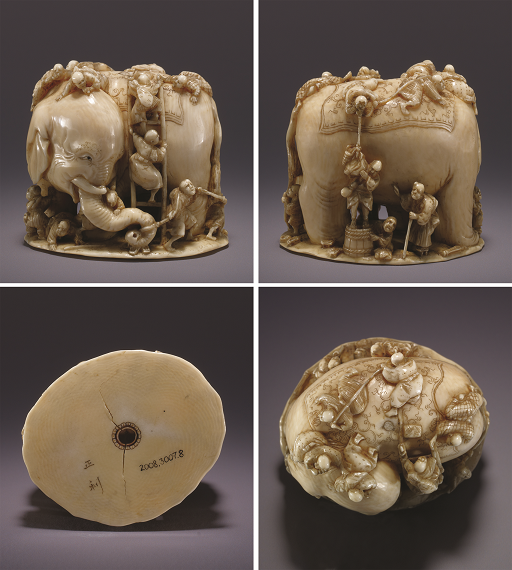2 Observation, interpretation and communication
Activity 1

Look at Figure 2. It shows four sides of an object. This is probably the first time you have met this object. In order to answer the questions below, you will need to:
- observe the object in the photographs (the caption provides a little information to help)
- interpret your observation
- communicate your observation.
Now answer the following questions:
- How big is the object?
- What is the object made of?
- What shape is the object?
- How was the object made?
- What colour is the object?
Discussion
- The caption helps: the object is 4.7cm long and 4cm deep. We might estimate it is 5cm high.
- The caption tells us it is ivory, but without that information we would struggle to say something like ‘a light-coloured, brownish-yellow substance with a reflective surface’. We might guess it to be ivory, but it could easily be stone or plastic. Even if we had guessed it is ivory, what kind of ivory is it? Is it elephant, mammoth, hippopotamus or walrus ivory? Only very detailed observation could tell us this. Perhaps an expert with a lens or a scientific analysis could provide an answer.
- The base is oval or nearly circular, the sides vertical and the top domed, although the surfaces are shaped further by the carving. The observation of this overall shape is consistent with the identification as ivory because the shape is generally that of a piece of tusk, possibly the pointed end, the material from which the object was fashioned.
- There are few visible clues as to how this object was made. Presumably the object was carved, but there are no obvious tool marks. The details of the design are very finely cut into the surface: the wrinkles around the elephant’s eye and tusk have been very carefully cut with a fine, sharp tool. Some of the details (the elephant’s eyebrows and the ground, for example) have been dotted in, presumably with the aid of a sharp tool. The hole in the underside was presumably drilled with a fine tool.
- The object has a variable colour. It is mostly brownish yellow, but the cut decoration is generally darker. Perhaps a coloured substance has been rubbed into the cut surface, but the darker areas could just be accumulated grime.
Limitations to your observation
It is worth remembering that you have been looking at photographs. If you had been able to hold the object in your hand, you would have had an immediate impression of its size (rather than having to get this information from the caption). By using your sense of touch you would have been able to make more observations – about the object’s weight and texture, for example. While holding it, you could have rotated the object to understand it in three dimensions, looked underneath it, examined the material (ivory) from which it has been crafted. With a magnifying glass, you could have seen more detail and been able to observe aspects of the object not visible to the naked eye.
Any observation of any object will always be limited in some way. Perhaps the object is dimly lit, or behind glass, or perhaps touching it is prohibited. Or, as in this case, perhaps you are seeing only a representation of the object. Nevertheless, our brains subconsciously do a lot of work on our behalf and help us to understand what we see in an image of an object as if it were a real object in front of us. Some aspects are difficult to grasp from a photograph, particularly a sense of scale (this object is only 4.7cm long) and an accurate perception of colour. So, all in all, any description based on photographs will never be able to capture all aspects of an object.
If observations are limited by various factors, then our ability to interpret what we observe is also limited by our previous knowledge or our ability to work out what we are looking at. With the object you have been studying, you might have observed the shape and details making up the various parts of an elephant. You probably also observed and recognised the ladder and the human figures. Some of the smaller parts are more difficult to observe and identify. As in the poem by Saxe, your interpretations are shaped by what you can observe.
